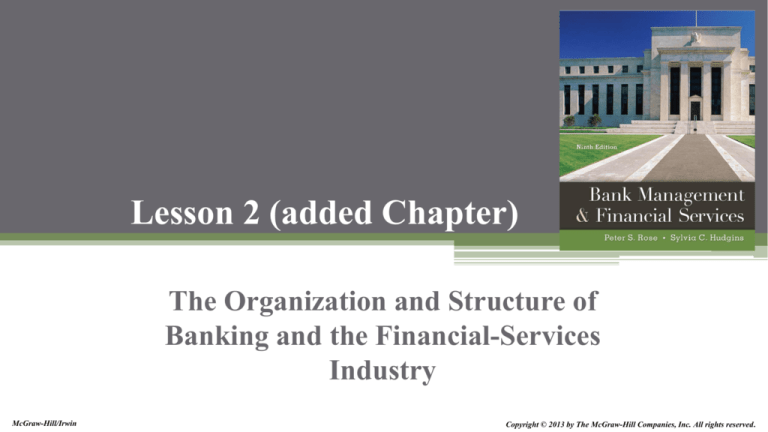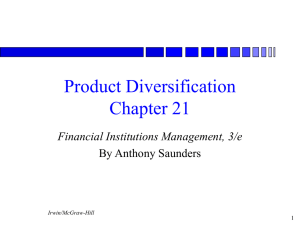
Lesson 2 (added Chapter)
The Organization and Structure of
Banking and the Financial-Services
Industry
McGraw-Hill/Irwin
Copyright © 2013 by The McGraw-Hill Companies, Inc. All rights reserved.
Key Topics
• The Organization & Structure of Banks & the
Banking Industry
• The Different types of Structures in Banking
• Interstate Banking and the Riegle-Neal Act
• The Financial Holding Company (FHC)
• Mergers and Acquisitions
• The Structure of Banking’s Main Competitors
• Economies of Scale and Scope
McGraw-Hill/Irwin
Bank Management and Financial Services, 7/e
© 2008 The McGraw-Hill Companies, Inc., All Rights Reserved.
3-2
Introduction
• Chapter 1 looked at many of the roles and
services of the modern bank and competitors
of banks
• Over the years, banks & competing financial
institutions have changed into different forms
• A financial institution’s role and size are not
the only way to know how well it performs
• In this chapter, we will discuss the causes that
have changed the structure, size, and types of
organizations in the financial-services industry
today
McGraw-Hill/Irwin
Bank Management and Financial Services, 7/e
© 2008 The McGraw-Hill Companies, Inc., All Rights Reserved.
3-3
The Organization and Structure of the
Commercial Banking Industry
• Size and Assets held by Banks
▫ Commercial banking is the main supplier of credit and
payments services to businesses and households
▫ Many banks in the United States are small
▫ They hold little more than one percent of total industry assets
▫ In contrast, the American banking industry also contains
some of the largest financial service organizations in the
world
▫ Citigroup, JP Morgan Chase, and the Bank of America hold about 6
trillion dollars combined. ICBC in China 3 trillion alone, the largest
bank in the world!
▫ Thus, banking continues to be concentrated in the very
largest of all financial firms. The ones “TOO BIG TO FAIL”
McGraw-Hill/Irwin
Bank Management and Financial Services, 7/e
© 2008 The McGraw-Hill Companies, Inc., All Rights Reserved.
3-4
The Structure of the U.S. Commercial Banking Industry,
December 31, 2009
McGraw-Hill/Irwin
Bank Management and Financial Services, 7/e
© 2008 The McGraw-Hill Companies, Inc., All Rights Reserved.
3-5
Organization of the Banking Firm
•The great difference in size across
the industry in recent years led to
many differences in the way
banks and other service providers
are organized and in the diversity
of financial services each
institution sells in their market.
McGraw-Hill/Irwin
Bank Management and Financial Services, 7/e
© 2008 The McGraw-Hill Companies, Inc., All Rights Reserved.
3-6
Small and Medium-Size U.S. Banks Lose Market Share to the
Largest Banking Institutions
McGraw-Hill/Irwin
Bank Management and Financial Services, 7/e
© 2008 The McGraw-Hill Companies, Inc., All Rights Reserved.
3-7
Organization of the Banking Firm (cont)
• Community Banks (Banks in neighborhoods & small
towns
▫ These smaller banks focus mainly on deposits and loans
and are called retail banks.
▫ Banks like this are quite different from wholesale banks,
which deal with large corporations or even government.
▫ Closer contact between top management and staff
▫ Community banks are greatly affected by changes in the
local economy and keeping up with new regulations
▫ These institutions have been going out of business
▫ Around 14,000 community banks in 1985 and about
6,000 in 2010
McGraw-Hill/Irwin
Bank Management and Financial Services, 7/e
© 2008 The McGraw-Hill Companies, Inc., All Rights Reserved.
3-8
Organization Chart for a Smaller Community Bank
McGraw-Hill/Irwin
Bank Management and Financial Services, 7/e
© 2008 The McGraw-Hill Companies, Inc., All Rights Reserved.
3-9
Internal Organization of the Banking Firm
(continued)
• Larger Banks – Money Center, Wholesale and Retail
▫ Large banks are located in big cities and serve large &
small retail customers (households) as well as large
business
▫ The largest money-center banks have advantages over
the smaller community banks
▫ Better diversified – both geographically and by
product line
▫ Can better withstand the risks of a changing economy
▫ Able to raise huge amounts of capital at low cost
McGraw-Hill/Irwin
▫ Can attract top managerial
© 2008 Thetalent
McGraw-Hill Companies, Inc., All Rights Reserved.
Bank Management and Financial Services, 7/e
3-10
Organization Chart for a Money Center or Wholesale Bank
Serving Domestic and International Markets
McGraw-Hill/Irwin
Bank Management and Financial Services, 7/e
© 2008 The McGraw-Hill Companies, Inc., All Rights Reserved.
3-11
Entry and Exit in U.S. Banking
McGraw-Hill/Irwin
Bank Management and Financial Services, 7/e
© 2008 The McGraw-Hill Companies, Inc., All Rights Reserved.
3-12
The Organizational Structure of Large Banks
• BANK BRANCHES
▫ Like a tree has many branches, as a bank grows larger in
size it usually decides at some point to establish a
branching organization
▫ They offer the full range of services from several
locations, including a head office and one or more fullservice branch offices
▫ Senior management of a branching organization is
usually located at the home office, though each fullservice branch has its own management team with limited
authority to make decisions
McGraw-Hill/Irwin
Bank Management and Financial Services, 7/e
© 2008 The McGraw-Hill Companies, Inc., All Rights Reserved.
3-13
The Branch Banking Organization
McGraw-Hill/Irwin
Bank Management and Financial Services, 7/e
© 2008 The McGraw-Hill Companies, Inc., All Rights Reserved.
3-14
The Organizational Structure of Large Banks
(cont)
• BRANCH BANKING GROWTH
▫ During the Great Depression of the 1930s, only one
in five American banks had a full-service branch
office
▫ By the beginning of the 21st century, the average
U.S. bank operated close to 12 full-service branch
offices
▫ The passage of the Riegle-Neal Interstate Banking
and Branching Efficiency Act in 1994 provided the
basis for expanding into new states.
McGraw-Hill/Irwin
Bank Management and Financial Services, 7/e
© 2008 The McGraw-Hill Companies, Inc., All Rights Reserved.
3-15
OTHER TYPES OF STRUCTURES
• Electronic Branching – Websites and
Electronic Networks: An Alternative or a
Supplement to Bank Branch Offices
▫ Electronic branches
▫ Internet banking services
▫ Automated teller machines (ATMs)
▫ Point-of-sale (POS) terminals
▫ Personal computers
▫ Call centers
McGraw-Hill/Irwin
Bank Management and Financial Services, 7/e
© 2008 The McGraw-Hill Companies, Inc., All Rights Reserved.
3-16
OTHER TYPES OF STRUCTURES (cont)
• Financial Holding Companies
▫ A bank holding company is a corporation created for
the purpose of holding the stock of at least one bank,
often along with other businesses
▫ The growth of holding companies has been rapid in
recent decades
▫ The principal reasons for this rapid upsurge:
▫ Access to capital markets in raising funds
▫ Ability to use higher leverage (debt)
▫ Tax advantages
▫ Ability to expand into businesses outside banking
▫ These banks hold up to 70% of the total assets of all
banks in the US
McGraw-Hill/Irwin
Bank Management and Financial Services, 7/e
© 2008 The McGraw-Hill Companies, Inc., All Rights Reserved.
3-17
The 10 Largest Bank Holding Companies Operating in the
United States (Total Assets as Reported on June 30, 2010)
McGraw-Hill/Irwin
Bank Management and Financial Services, 7/e
© 2008 The McGraw-Hill Companies, Inc., All Rights Reserved.
3-18
The Most Important Nonbank Financially Related Businesses
That Registered Holding Companies
Can Acquire under U.S. Banking Regulations
McGraw-Hill/Irwin
Bank Management and Financial Services, 7/e
© 2008 The McGraw-Hill Companies, Inc., All Rights Reserved.
3-19
EXHIBIT 3–8 The Multibank Holding Company
McGraw-Hill/Irwin
Bank Management and Financial Services, 7/e
© 2008 The McGraw-Hill Companies, Inc., All Rights Reserved.
3-20
FINANCIAL HOLDING COMPANIES (cont)
• As a review from last semester what are some of
advantages and disadvantages of these large financial
companies?
FOR (PROS)
McGraw-Hill/Irwin
Bank Management and Financial Services, 7/e
AGAINST (CONS)
© 2008 The McGraw-Hill Companies, Inc., All Rights Reserved.
3-21
FINANCIAL HOLDING COMPANIES (cont)
• Holding company banking has been blamed for
reducing competition
• Supporters say they are more efficient, have more
services, lower chance of failure, and higher and
more profits
• Moreover, the failure rate for holding company banks
appears to be below that of same size independent
banks
• However, there is evidence that multibank holding
companies may drain capital from some communities
McGraw-Hill/Irwin
and weaken smaller towns
© 2008 The McGraw-Hill Companies, Inc., All Rights Reserved.
Bank Management and Financial Services, 7/e
3-22
An Alternative Type of Banking Organization Available
as the 21st Century Opened: Financial Holding
Companies (FHCs)
• Under the terms of the Gramm-Leach-Bliley (GLB)
Act 1999, financial holding companies (FHCs) are
defined as a special type of holding company that
offers many financial services, including dealing in
selling securities and insurance
• Led to consolidation ( getting bigger ) and
convergence (many different kinds of products)
within the industry. Investment banks can once again
join together with commercial banks
• What do we call these 2 concepts (size and
diversity)?
© 2008 The McGraw-Hill Companies, Inc., All Rights Reserved.
McGraw-Hill/Irwin
Bank Management and Financial Services, 7/e
3-25
The Financial Holding Company (FHC)
McGraw-Hill/Irwin
Bank Management and Financial Services, 7/e
© 2008 The McGraw-Hill Companies, Inc., All Rights Reserved.
3-26
Leading Financial Holding Companies (FHCs) Registered
with the Federal Reserve Board
McGraw-Hill/Irwin
Bank Management and Financial Services, 7/e
© 2008 The McGraw-Hill Companies, Inc., All Rights Reserved.
3-27
Mergers and Acquisitions Reshaping the Structure and
Organization of the Financial-Services Sector
• Bigger companies have been buying up
smaller financial-service providers and
purchased their assets in great numbers
▫ Since 1980 more than 12,000 bank mergers
have occurred in the United States.
▫ I was involved in training bankers in 3
mergers while I worked with the bank. We
many banks and non-depository firms as
well.
McGraw-Hill/Irwin
Bank Management and Financial Services, 7/e
© 2008 The McGraw-Hill Companies, Inc., All Rights Reserved.
3-28
The Changing Organization and Structure of
Banking’s Principal Competitors
• Banking’s principal competitors – credit unions, savings
associations, finance companies, insurance firms, pension fund
and mutual fund companies, security dealers, hedge funds,
investment banks and other financial firms.
• It’s all becoming blurry in many ways to know banks from
other financial service companies.
• All are affected by powerful forces such as rising operating
costs and rapidly changing technology
• The one-stop shop has become almost normal.
McGraw-Hill/Irwin
Bank Management and Financial Services, 7/e
© 2008 The McGraw-Hill Companies, Inc., All Rights Reserved.
3-29
Efficiency and Size: Do Bigger Financial
Firms Operate at Lower Cost?
• If not, then why have some financial
institutions become some of the
largest businesses on the planet?
• Two possible sources of cost savings
▫ Economies of scale
▫ Economies of scope
McGraw-Hill/Irwin
Bank Management and Financial Services, 7/e
© 2008 The McGraw-Hill Companies, Inc., All Rights Reserved.
3-30
Quick Quiz – HOMEWORK FOR 3/23/15
3. What
trends are affecting the way banks and their
competitors are organized today?
7. What trend in branch banking has been prominent in
the United States in recent years?
9. What is a bank holding company?
McGraw-Hill/Irwin
Bank Management and Financial Services, 7/e
© 2008 The McGraw-Hill Companies, Inc., All Rights Reserved.
3-31
Quick Quiz – HOMEWORK FOR 3/23/15
12. Are there any significant advantages or
disadvantages for holding companies or the public if
these companies buy banks or nonbank business
ventures?
14. Can you see any advantages to allowing interstate
banking? What about potential disadvantages?
16. What relationship appears to exist between bank
size, efficiency, and operating costs per unit of service
McGraw-Hill/Irwin
produced
and
delivered?
© 2008 The McGraw-Hill Companies, Inc., All Rights Reserved.
Bank Management and Financial Services, 7/e
3-32






